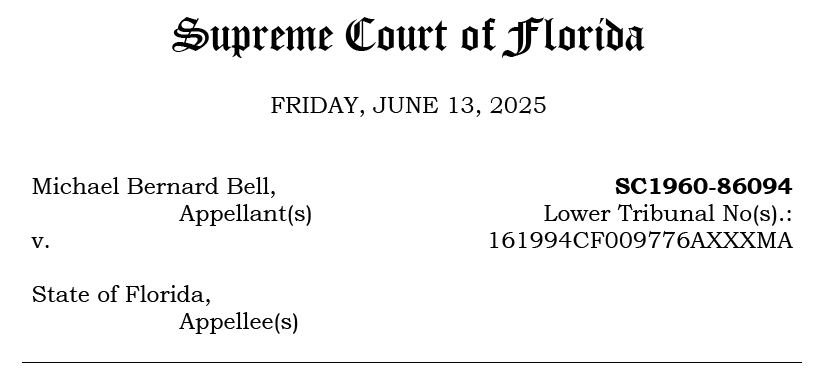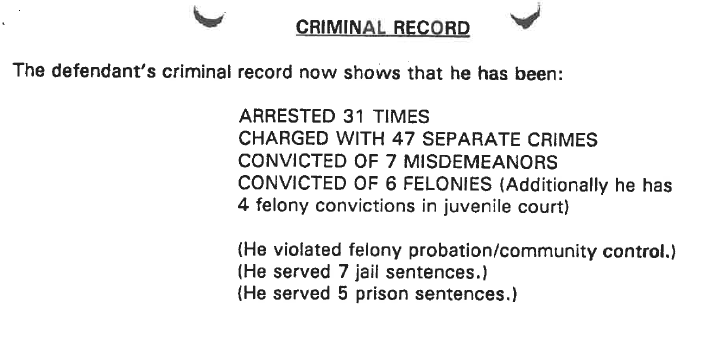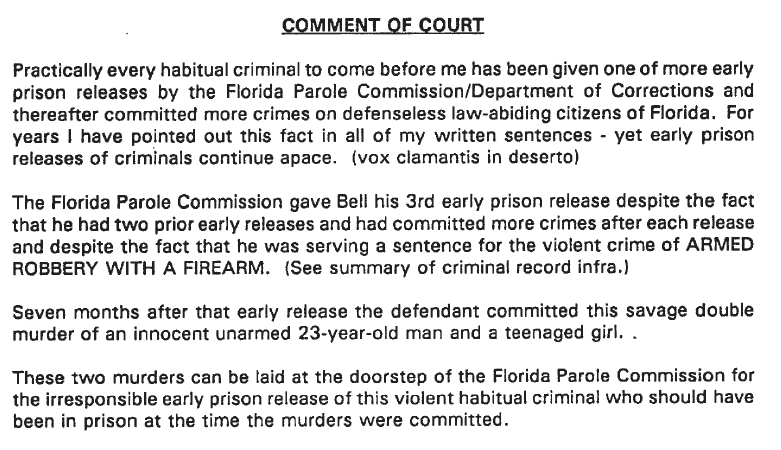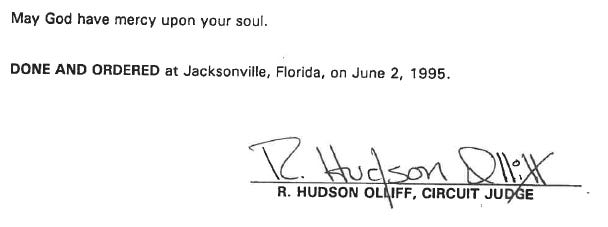NEW WARRANT: Michael Bell's execution scheduled July 15
Gov. DeSantis has signed a death warrant scheduling Michael Bell's execution for July 15 at 6:00 p.m.
Gov. DeSantis has signed a death warrant scheduling Michael Bell’s execution for July 15 at 6:00 p.m.
Shortly after the Governor issued the warrant, the Florida Supreme Court issued its standard scheduling order for warrant-related litigation.
The Order sets forth the following schedule:
June 24 at 11:00 a.m.: Circuit court proceedings must be completed.
June 24 at 1:00 p.m.: Notice of appeal and writ petition due
June 25 at 5:00 p.m.: Initial brief due
June 27 at 5:00 p.m.: Answer brief due
June 30 at 11:00 a.m.: Reply brief due
The full scheduling order can be found on the Court’s docket here. Strangely, the warrant itself is not yet available. This post will be updated when it is.
Background of Bell’s Case
Trial & Direct Appeal
In June 1995, a Duval County jury convicted Michael Bell of two counts of first-degree murder for killing Jimmy West and Tamecka Smith “outside a liquor lounge in Jacksonville” in June 1993. The Florida Supreme Court explained the facts as follows:
In June 1993, Theodore Wright killed Lamar Bell in a shoot-out which was found to be justifiable homicide committed in self-defense. Michael Bell then swore to get revenge for the murder of his brother, Lamar Bell. During the five months following Lamar Bell's death, Michael Bell repeatedly told friends and relatives he planned to kill Wright. On December 8, 1993, Michael Bell, through a girlfriend, purchased an AK–47 assault rifle, a thirty-round magazine, and 160 bullets. The next night, Bell saw Theodore Wright’s car, a yellow Plymouth. Bell left the area and shortly returned with two friends and his rifle loaded with thirty bullets. After a short search, he saw the yellow car in the parking lot of a liquor lounge. Bell did not know that Wright had sold the car to Wright's half-brother, Jimmy West, and that West had parked it and had gone into the lounge. Bell waited in the parking lot until West left the lounge with Tamecka Smith and another female. Bell picked up the loaded AK–47 and approached the car as West got into the driver's seat and Smith began to enter on the passenger's side. Bell approached the open door on the driver's side and at point-blank range fired twelve bullets into West and four into Smith. The other female ducked and escaped injury. After shooting West and Smith, Bell riddled with bullets the front of the lounge where about a dozen people were waiting to go inside. Bell then drove to his aunt's house and said to her, “Theodore got my brother and now I got his brother.”1
At trial, “[t]he defense presented no evidence or witnesses.”
The prosecutor on Bell’s case, George Bateh, was the same as Kenneth Hartley, whose case was recently covered by The Tributary here.
After convicting Bell, the jury “unanimously recommended the death penalty for both murders.”2
In the Sentencing Order, the Court commented on the jury’s unanimous recommendation:
The trial court followed the jury’s recommendation and sentenced Bell to death on both counts, “finding three aggravating circumstances and one marginal statutory mitigating circumstance.”3
In the Sentencing Order, the trial court noted Bell’s criminal history:
The court further commented on the fact that Bell had previously been granted early release three times, saying the murders “can be laid at the doorstep of the Florida Parole Commission for the irresponsible early prison release” it granted Bell:
Further, the Sentencing Order states that Bell was “awaiting trial on another first degree murder which was committed 83 days after his early prison release.”
According to The Times-Union, the Judge who sentenced Bell was nicknamed the “hanging judge” because he was known for passing out harsh sentences.
On July 17, 1997, the Florida Supreme Court affirmed Bell’s convictions and death sentences on direct appeal.4 The Court’s opinion indicates that Bell complained two times before trial about his attorney’s representation.5 Justice Shaw concurred in result only as to conviction and concurred as to sentence but did not explain why. His sentences became final on February 23, 1998.
Initial Postconviction & Habeas Petitions
On June 1, 1999, Bell’s initial motion for postconviction relief was filed. The circuit court summarily denied the motion on January 13, 2000. In 2001, the Florida Supreme Court reversed summary denial and remanded for the circuit court to hold an evidentiary hearing.6
On remand, the circuit court granted Bell’s motion to represent himself in postconviction. Pro se, Bell filed an amended motion for postconviction relief that raised 29 claims. After an evidentiary hearing, on May 31, 2002, the circuit court denied Bell’s claims.
Bell appealed, raising 24 claims. Bell also filed a petition for writ of habeas corpus, raising 8 claims:
(1) appellate counsel was ineffective for improperly arguing Bell's claim on direct appeal that Bell should have been permitted to represent himself at trial; (2) appellate counsel was ineffective for failing to raise on direct appeal the erroneous excusal for cause of a prospective juror by the trial court; (3) appellate counsel was ineffective for failing to raise on direct appeal the trial court's error in permitting Bell to wear his jail uniform in front of the jury; (4) appellate counsel had a conflict of interest which rendered his assistance ineffective; (5) appellate counsel was ineffective for failing to raise on direct appeal the issue of erroneous jury instructions; (6) appellate counsel was ineffective for failing to argue on direct appeal that comments made in voir dire were reversible error; (7) Bell's death sentence is unconstitutional under Apprendi v. New Jersey, 530 U.S. 466, 120 S.Ct. 2348, 147 L.Ed.2d 435 (2000); and (8) the trial court gave unconstitutional jury instructions.
On June 7, 2007, the Florida Supreme Court affirmed the circuit court’s denial of Bell’s motion and denied Bell’s petition.7
Federal Habeas
After his initial motion for postconviction relief was denied, Bell sought federal habeas relief. On January 15, 2009, the federal district court granted the state’s motion for summary judgment, concluding that Bell’s petition was untimely.8 On February 7, 2012, the U.S. Court of Appeals for the Eleventh Circuit issued an opinion affirming the U.S. District Court for the Middle District’s ruling.9 In other words, Bell’s federal habeas petition was never reviewed on the merits.
First Successive Postconviction Motion
In November 2010, Bell filed a successive motion for postconviction relief. On March 17, 2011, the circuit court summarily denied Bell’s motion.10 On appeal, the Florida Supreme Court affirmed the denial.
Second Successive Postconviction Motion
In October 2016, the Florida Supreme Court unanimously affirmed the circuit court’s order striking Bell’s second successive postconviction motion.11
Hurst Motion
After Hurst, Bell filed a successive motion for postconviction relief.12 In 2018, the Florida Supreme Court affirmed the circuit court’s denial of Bell’s motion because his sentence of death became final before 2002. Note, though, that Bell likely would not have otherwise received Hurst relief under the Court’s framework because the jury’s original recommendations for death was unanimous.
Buck Motion
On February 20, 2018, Bell filed, through counsel, a successive motion for postconviction relief seeking relief under Buck v. Davis from the U.S. Supreme Court in 2017. Bell argued that “Buck created new law when it went farther than any court had gone before regarding trial counsel's deficient performance by injecting race into the trial and the resulting prejudice.”13
The circuit court denied the motion in September 2018 finding that it was procedurally barred and otherwise without merit.
On November 7, 2019, the Florida Supreme Court affirmed the denial.14 The Court held that Buck did not create any new rule and that Bell’s motion was procedurally barred.
News Articles
My thoughts are with everyone involved in the warrant- and execution-related process.
Bell v. State, 699 So. 2d 674, 675-76 (Fla. 1997).
Id. (footnotes omitted).
Id.
Id.
Id. at 676.
See generally Bell v. State, 790 So. 2d 1101 (Fla. 2001).
See generally Bell v. State, 965 So. 2d 48 (Fla. 2007).
Bell v. McDonough v. 2009 WL 10698415 (M.D. Fla. Jan. 15, 2009).
Bell v. Fla. Att’y Gen., 461 F. App’x 843 (11th Cir. 2012).
State v. Bell, No. 16-1994-CF-009776, 2011 WL 13382808 (Fla. 4th Jud. Cir. Mar. 17, 2011).
Bell v. State, 2016 WL 5888880 (Fla. Oct. 10, 2016).
State v. Bell, No. 16-1994-CF-009776, 2018 WL 11192813 (Fla. 4th Jud. Cir. Sept. 28, 2018).
Bell v. State, 284 So. 3d 400 (Fla. 2019).











What is the purpose of the death penalty? Please explain it to me.
Mr. Bell is on death row and has been for decades. Executing him now does not make anyone safer. It will only bring back pain to the victim's family and to his family. He is not the same man he was back then. His life should be spared. My opinion in no way ignores the plight of the victims and their families. They deserve justice and it has been meted out by Mr. Bell being in prison. Living in prison is torture enough.